- JavaScript Algorithms and Data Structures Masterclass(Udemy Course)
트리는 부모/자식 관계에 있는 노드들로 구성된 자료 구조이다.
-
트리의 종류
-
트리
-
이진 트리
-
이진 검색 트리
-
자가 균형 이진 검색 트리(AVL 트리)
-
-
예시
-
HTML DOM
-
네트워크 라우팅
-
Abstract Syntax Tree
(컴파일의 3단계 중 2단계인 Parsing의 결과물이다) -
인공지능(minimax tree?)
-
운영체제의 디렉토리
-
컴퓨터 파일 시스템
-
이진 검색 트리
-
모든 부모 노드는 최대 2개의 자식 노드를 갖는다.
-
부모 노드의 왼쪽 자식은 부모 노드보다 작은 값이며, 부모 노드의 오른쪽 자식은 부모 노드보다 큰 값이다.
모든 부모 노드는 최대 2개의 자식 노드를 갖는다.
const Node = {
init: function (val) {
this.val = val;
this.left = null;
this.right = null;
},
};트리는 루트 노드로부터 진입한다.
const BinarySearchTree = {
init: function () {
this.root = null;
},
};insert
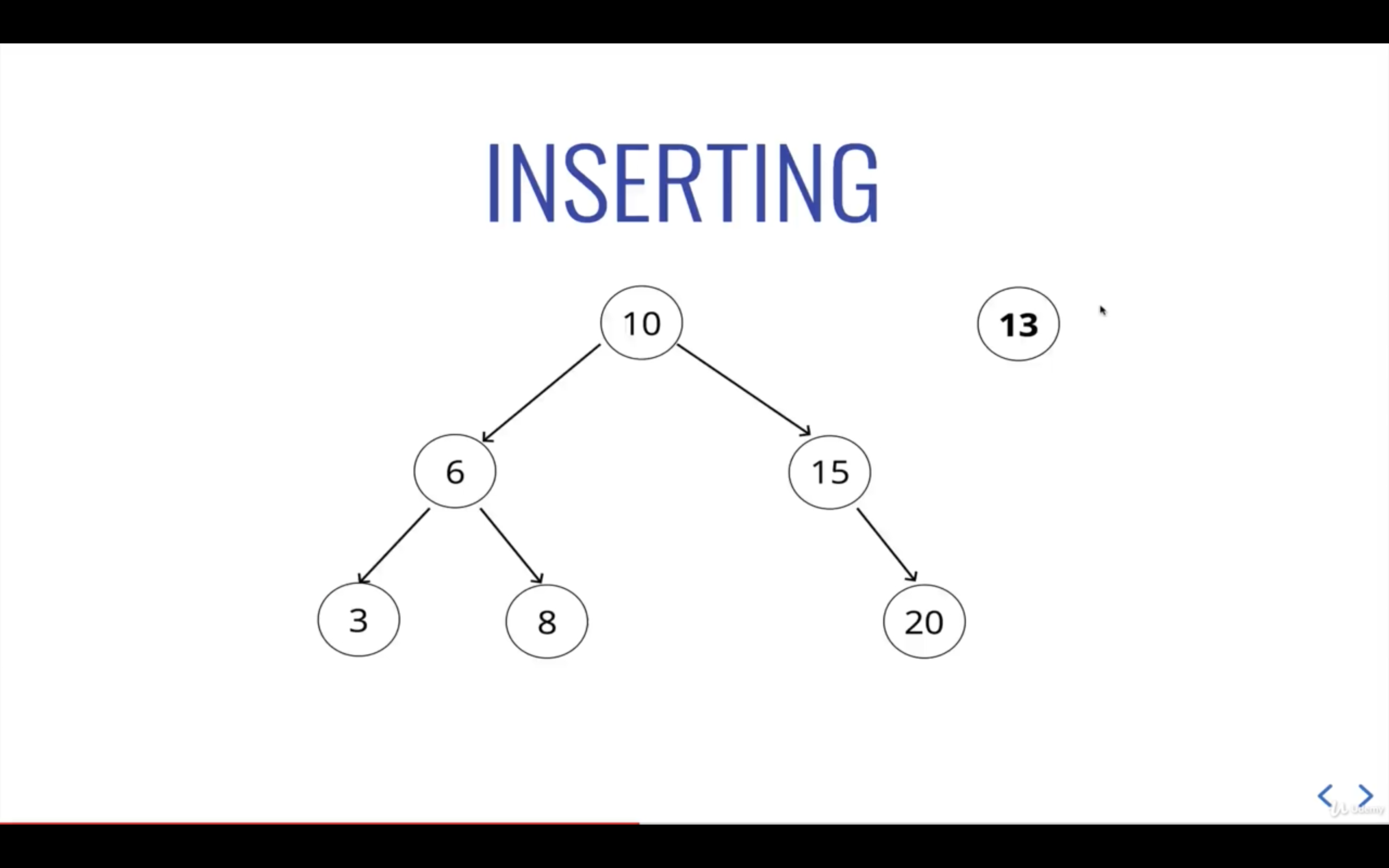
- 위 그림과 같이 트리 구조를 구현하기 위해 insert함수를 사용한다고 가정해보자.
const BinarySearchTree = {
// 앞 생략
insert: function (val) {
const newNode = Object.create(Node);
newNode.init(val);
if (!this.root) {
this.root = newNode;
return this;
}
let currentNode = this.root;
while (true) {
if (val == currentNode.val) {
return currentNode;
}
if (val < currentNode.val) {
if (currentNode.left == null) {
currentNode.left = newNode;
return this;
}
currentNode = currentNode.left;
continue;
}
if (val > currentNode.val) {
if (currentNode.right == null) {
currentNode.right = newNode;
return this;
}
currentNode = currentNode.right;
continue;
}
}
},
};
const bst = Object.create(BinarySearchTree);
bst.init();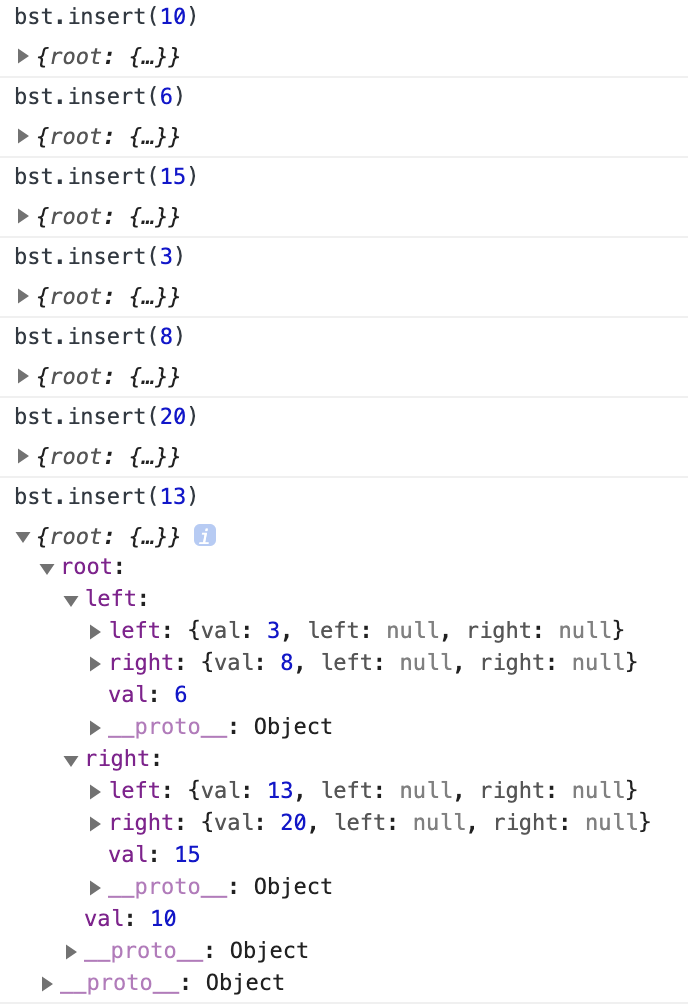
find
const BinarySearchTree = {
// 앞 생략
find: function (val) {
if (!this.root) {
return;
}
let currentNode = this.root;
while (true) {
if (val == currentNode.val) {
return currentNode;
}
if (val < currentNode.val) {
if (currentNode.left) {
currentNode = currentNode.left;
continue;
}
return;
}
if (val > currentNode.val) {
if (currentNode.right) {
currentNode = currentNode.right;
continue;
}
return;
}
}
},
};
const bst = Object.create(BinarySearchTree);
bst.init();
bst.insert(10);
bst.insert(6);
bst.insert(15);
bst.insert(3);
bst.insert(8);
bst.insert(13);
bst.insert(20);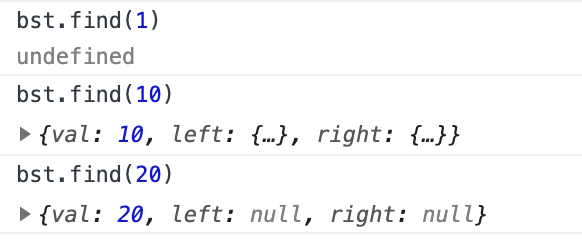
이진 검색 트리의 삽입과 검색의 시간 복잡도

-
위와 같이 균형을 이루는 이진 검색 트리의 경우, 계층이 하나 깊어질 때마다 이전 계층의 노드 수의 2배가 늘어난다.
-
따라서 insert와 find의 시간 복잡도는 log n이 된다.
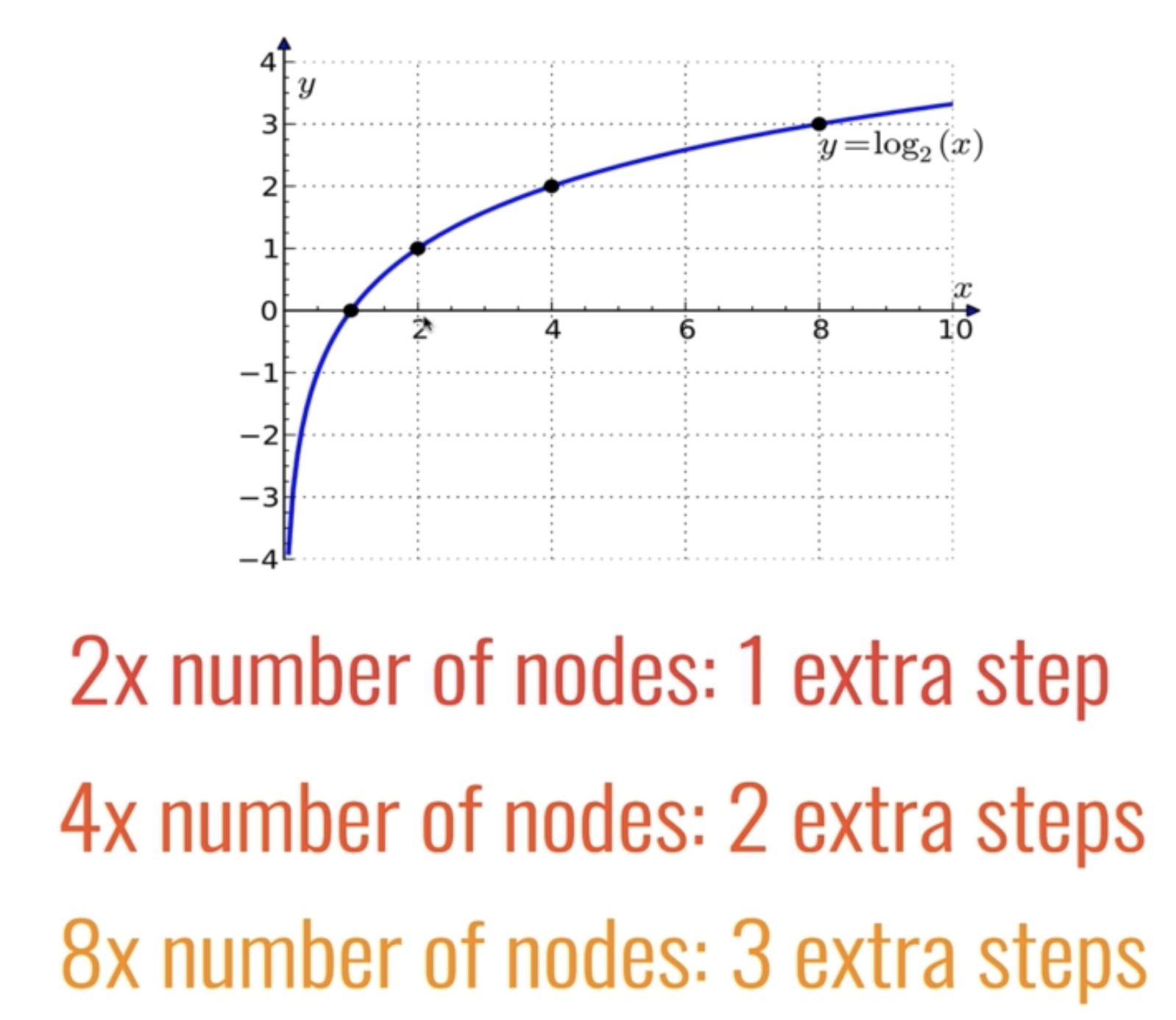
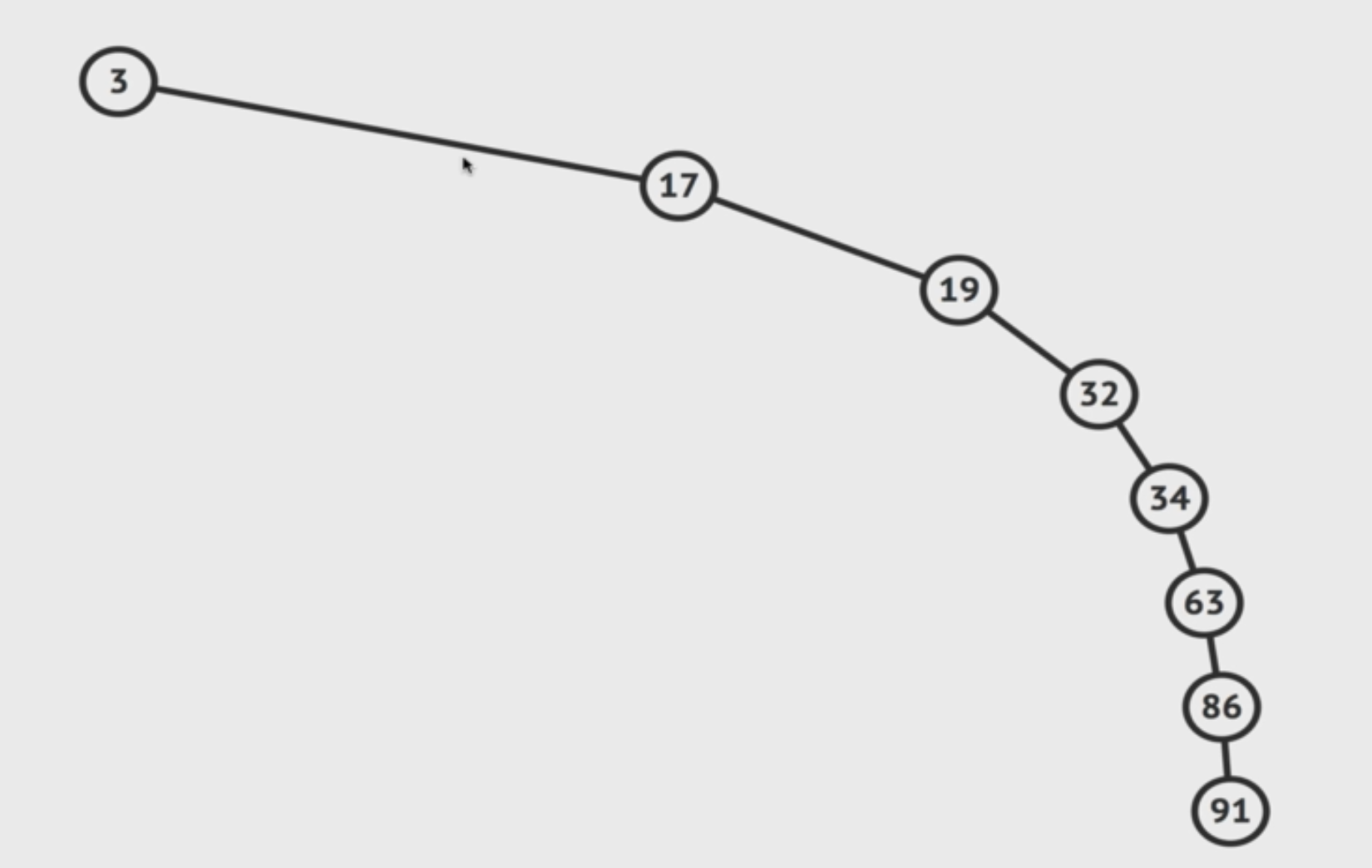
- 하지만 위와 같이 균형을 이루지 못한 이진 검색 트리의 경우, 연결 리스트와 다를 것이 없어 insert와 find의 시간 복잡도는 최대 n까지 올라간다.
트리 순회
- 이 절의 내용은 비단 '이진 검색 트리'에만 해당되는 내용이 아니라 모든 종류의 트리에 적용된다.
너비 우선 탐색(BFS)
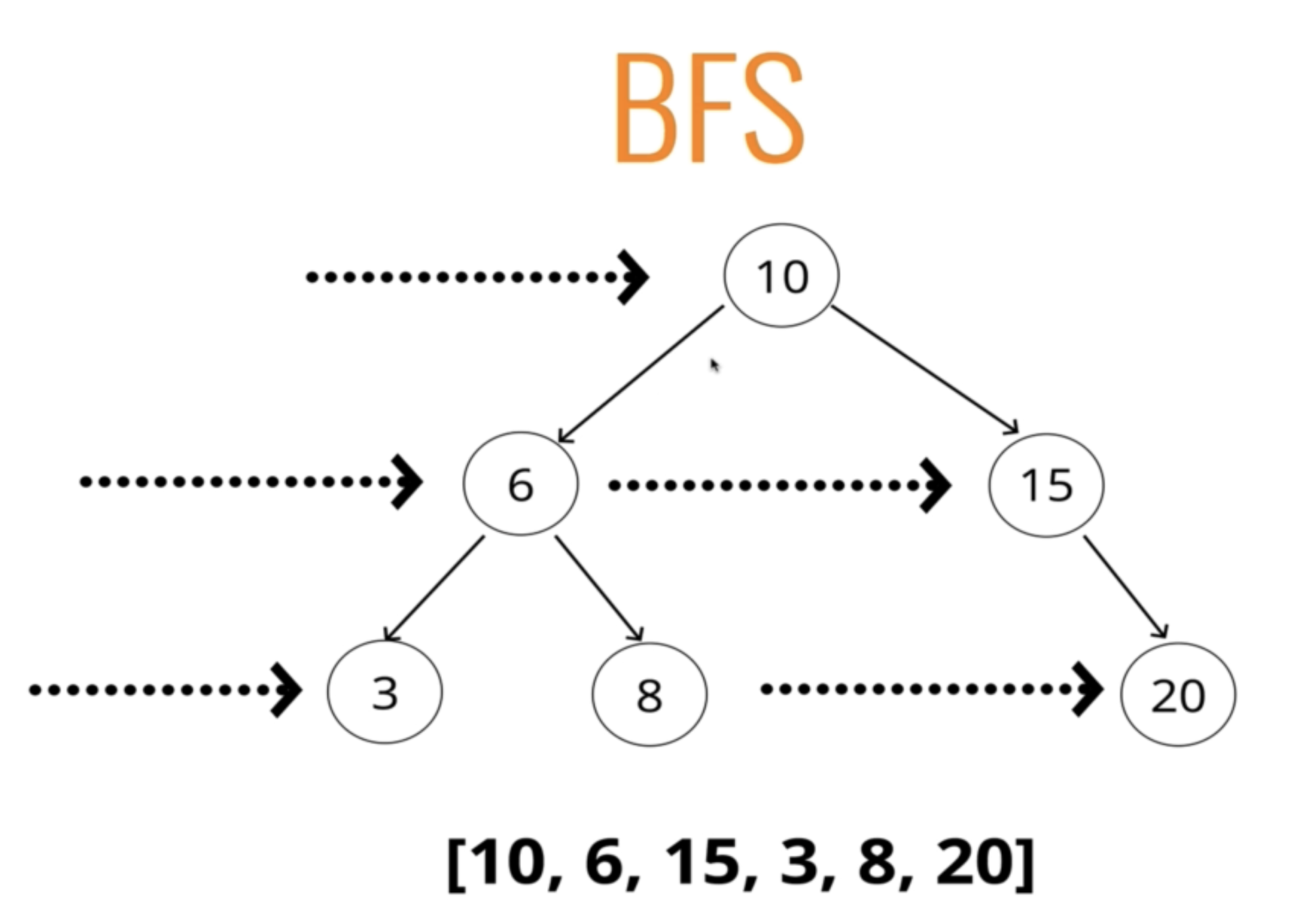
재귀함수로 BFS 짜기
const BinarySearchTree = {
// 앞 생략
bfsByRecursion: function (queue = [this.root], visited = []) {
if (queue.length == 0) {
return visited;
}
const shifted = queue.shift();
if (shifted.left) {
queue.push(shifted.left);
}
if (shifted.right) {
queue.push(shifted.right);
}
visited.push(shifted.val);
debugger;
return this.bfsByRecursion(queue, visited);
},
};
const bst = Object.create(BinarySearchTree);
bst.init();
bst.insert(10);
bst.insert(6);
bst.insert(3);
bst.insert(8);
bst.insert(15);
bst.insert(20);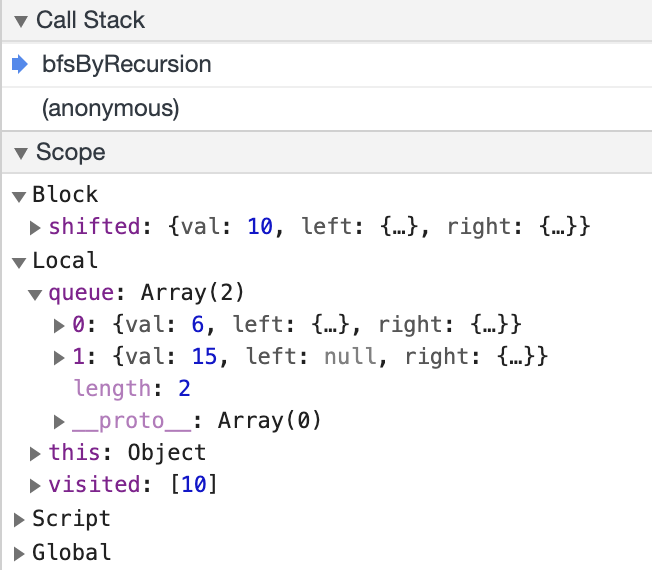
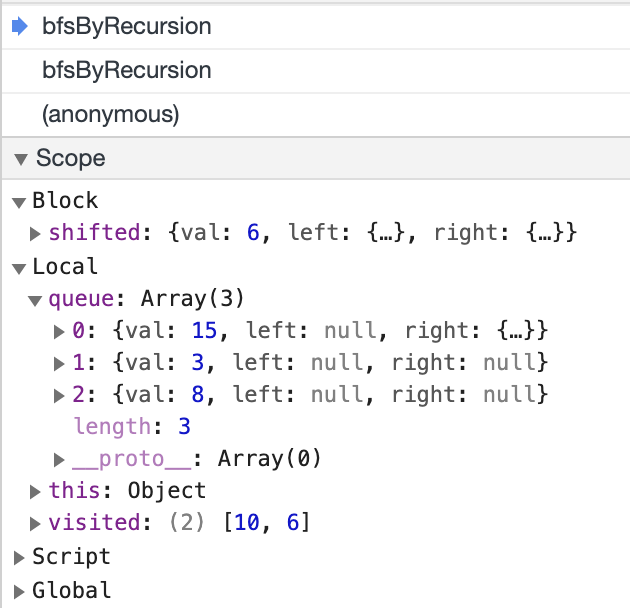
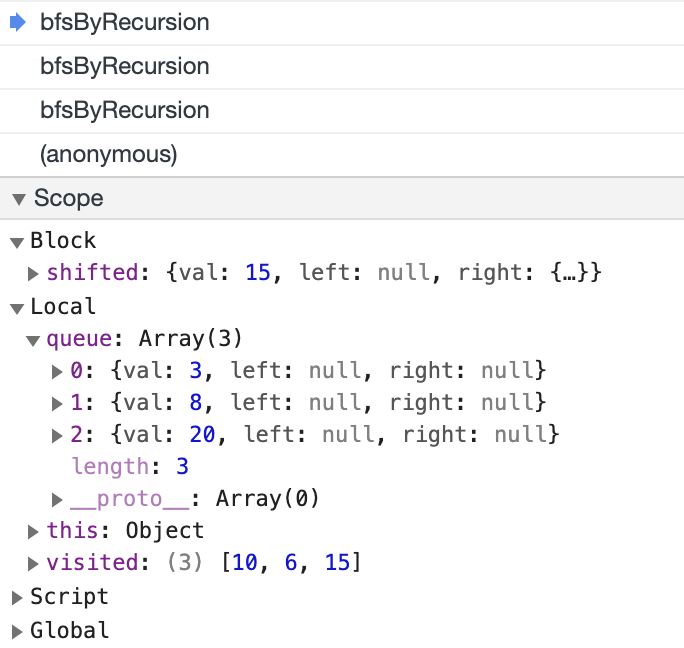
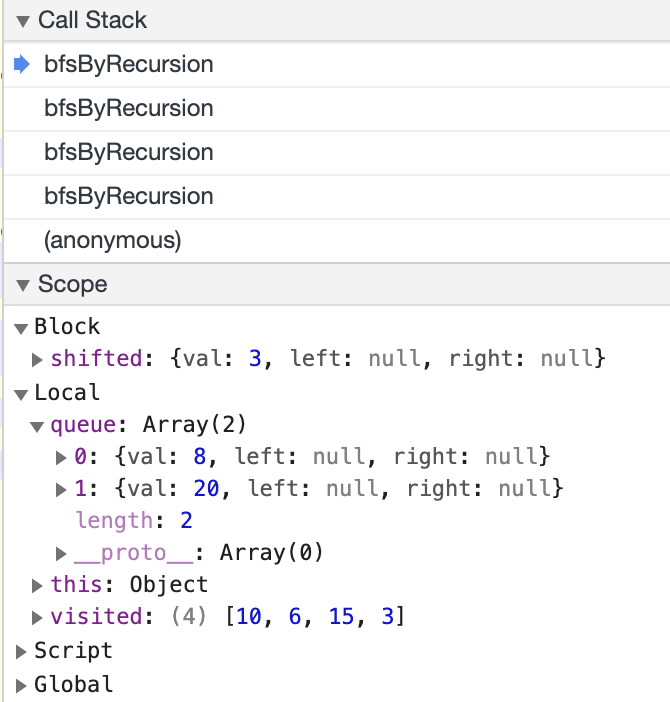
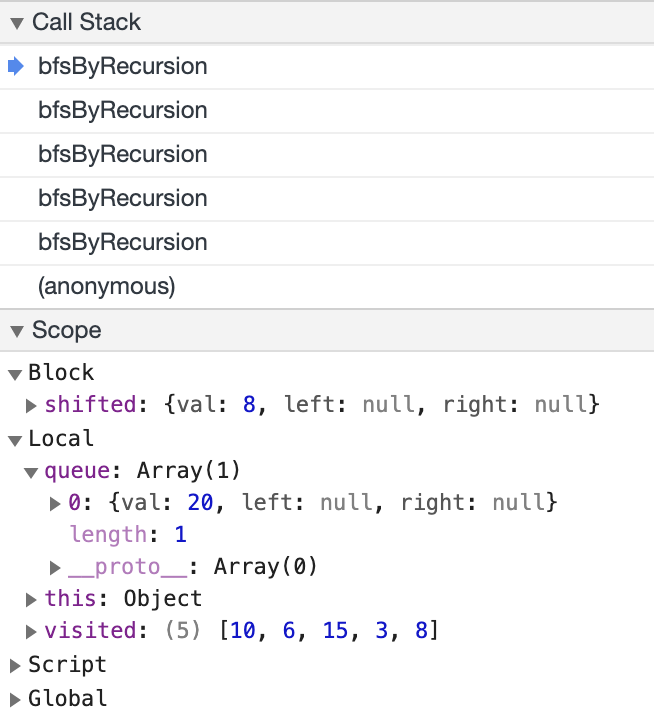
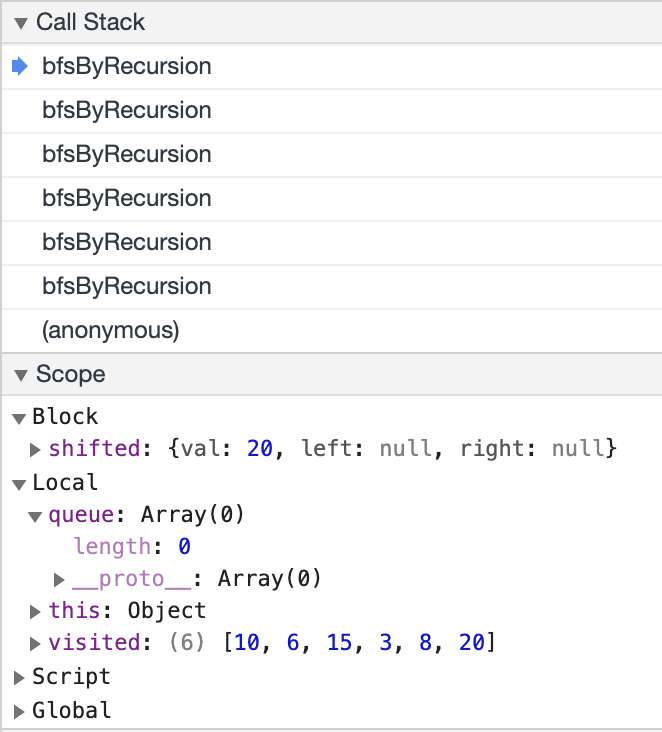
- 이와 같이 재귀함수는 값을 반환하기 최종 값을 반환하기까지 콜스택이 계속 쌓이게 되므로 트리의 규모가 크다면 stack overflow가 발생할 수도 있다.
반복문으로 BFS 짜기
const BinarySearchTree = {
// 앞 생략
bfsByLoop: function () {
const queue = [this.root];
const visited = [];
while (queue.length) {
const shifted = queue.shift();
if (shifted.left) {
queue.push(shifted.left);
}
if (shifted.right) {
queue.push(shifted.right);
}
visited.push(shifted.val);
debugger;
}
return visited;
},
};
const bst = Object.create(BinarySearchTree);
bst.init();
bst.insert(10);
bst.insert(6);
bst.insert(3);
bst.insert(8);
bst.insert(15);
bst.insert(20);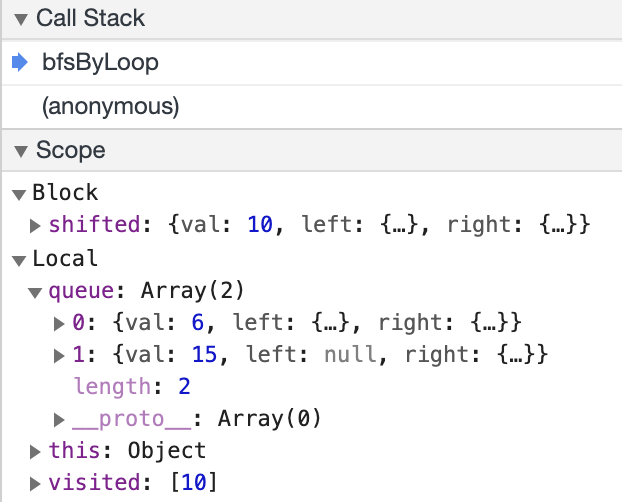
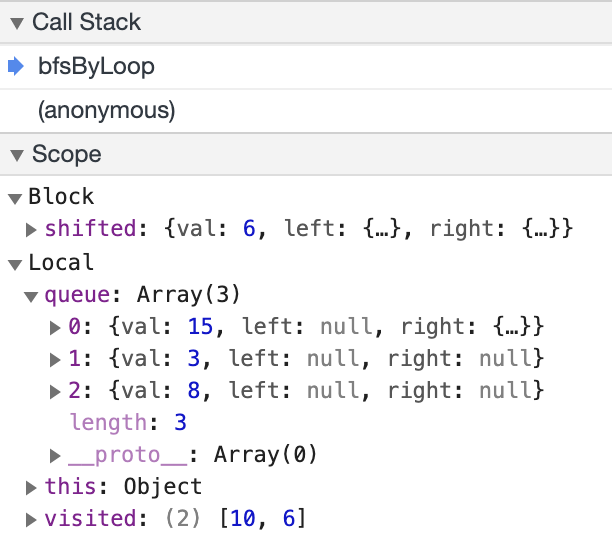
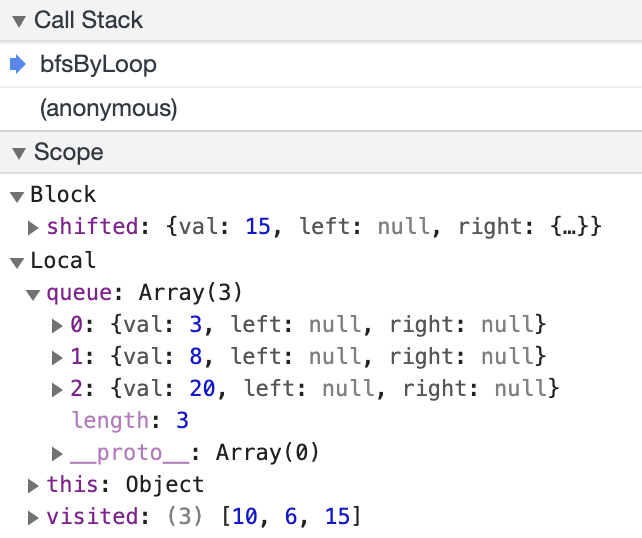
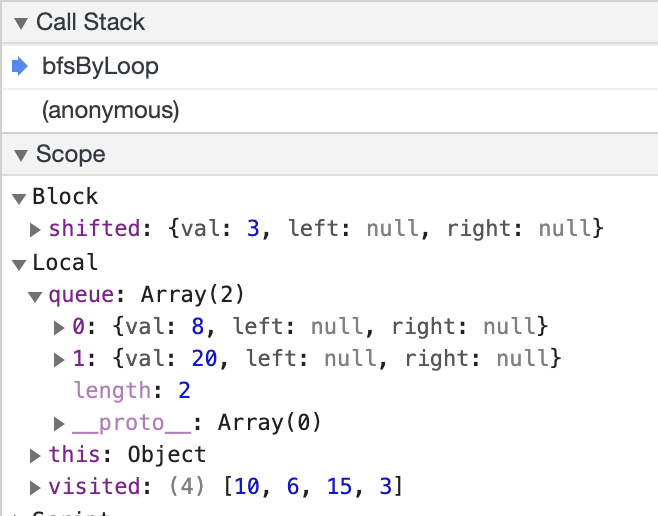
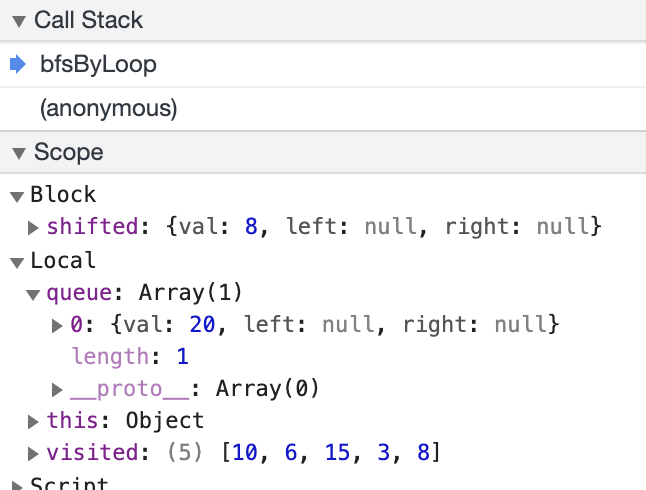
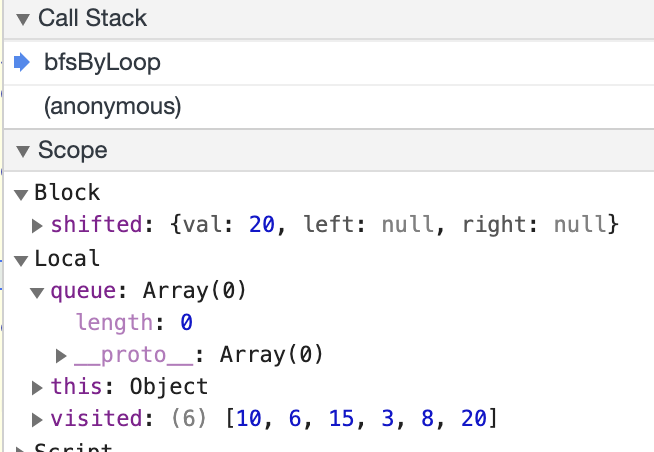
-
반면, 반복문을 이용할 경우 하나의 콜스택에서 문제를 해결한다.
-
따라서 재귀문과 반복문으로 해결이 가능한 문제라면 반복문으로 해결하는 편이 좋다.
깊이 우선 탐색(DFS)
선순위(pre-order) DFS
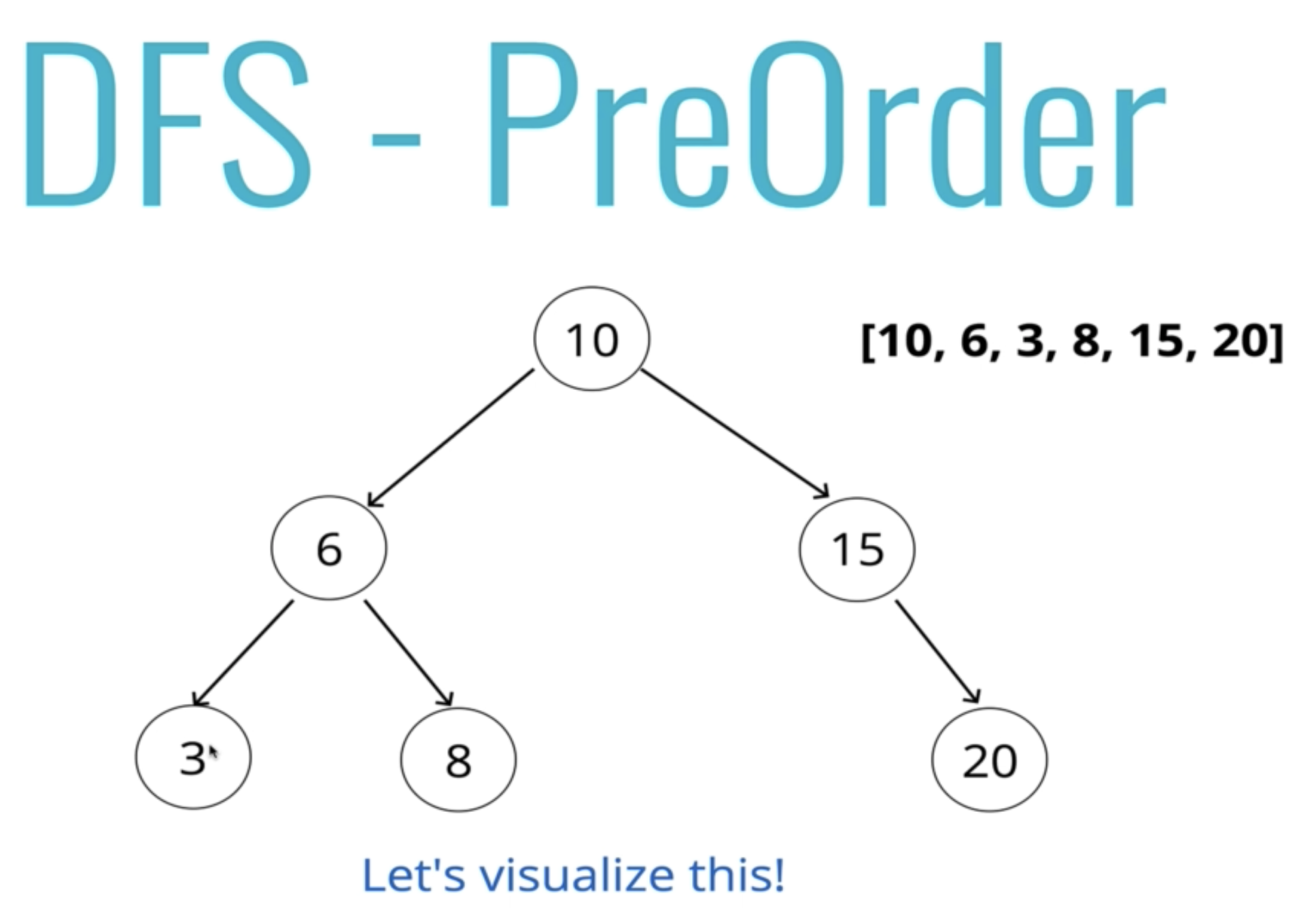
반복문
const BinarySearchTree = {
// 앞 생략
preOrderDFSByLoop: function () {
const stack = [this.root];
const visited = [];
while (stack.length) {
const popped = stack.pop();
if (popped.right) {
stack.push(popped.right);
}
if (popped.left) {
stack.push(popped.left);
}
visited.push(popped.val);
debugger;
}
return visited;
},
};
const bst = Object.create(BinarySearchTree);
bst.init();
bst.insert(10);
bst.insert(6);
bst.insert(3);
bst.insert(8);
bst.insert(15);
bst.insert(20);재귀문(내 풀이)
const BinarySearchTree = {
// 앞 생략
preOrderDFSByRecursive: function (stack = [this.root], visited = []) {
if (stack.length == 0) {
return visited;
}
const popped = stack.pop();
if (popped.right) {
stack.push(popped.right);
}
if (popped.left) {
stack.push(popped.left);
}
visited.push(popped.val);
// debugger;
return this.preOrderDFSByRecursive(stack, visited);
},
};
const bst = Object.create(BinarySearchTree);
bst.init();
bst.insert(10);
bst.insert(6);
bst.insert(3);
bst.insert(8);
bst.insert(15);
bst.insert(20);-
helper함수를 쓰지 않고 재귀문으로 풀려는 시도였다.
-
다만, 이 방식으로는 post-order와 in-order를 풀 수 없다.
(풀 수 있겠지... 내가 모를 뿐 ㅠ)
재귀문(Colt풀이)
const BinarySearchTree = {
// 앞 생략
preOrderDFSByRecursive: function () {
const visited = [];
function traverse(node) {
visited.push(node.val);
if (node.left) {
traverse(node.left);
}
if (node.right) {
traverse(node.right);
}
}
traverse(this.root);
return visited;
},
};
const bst = Object.create(BinarySearchTree);
bst.init();
bst.insert(10);
bst.insert(6);
bst.insert(3);
bst.insert(8);
bst.insert(15);
bst.insert(20);- 이 방식을 활용하면 아래의 post-order와 pre-order의 구현도 쉽게 할 수 있다.
후순위(post-order) DFS
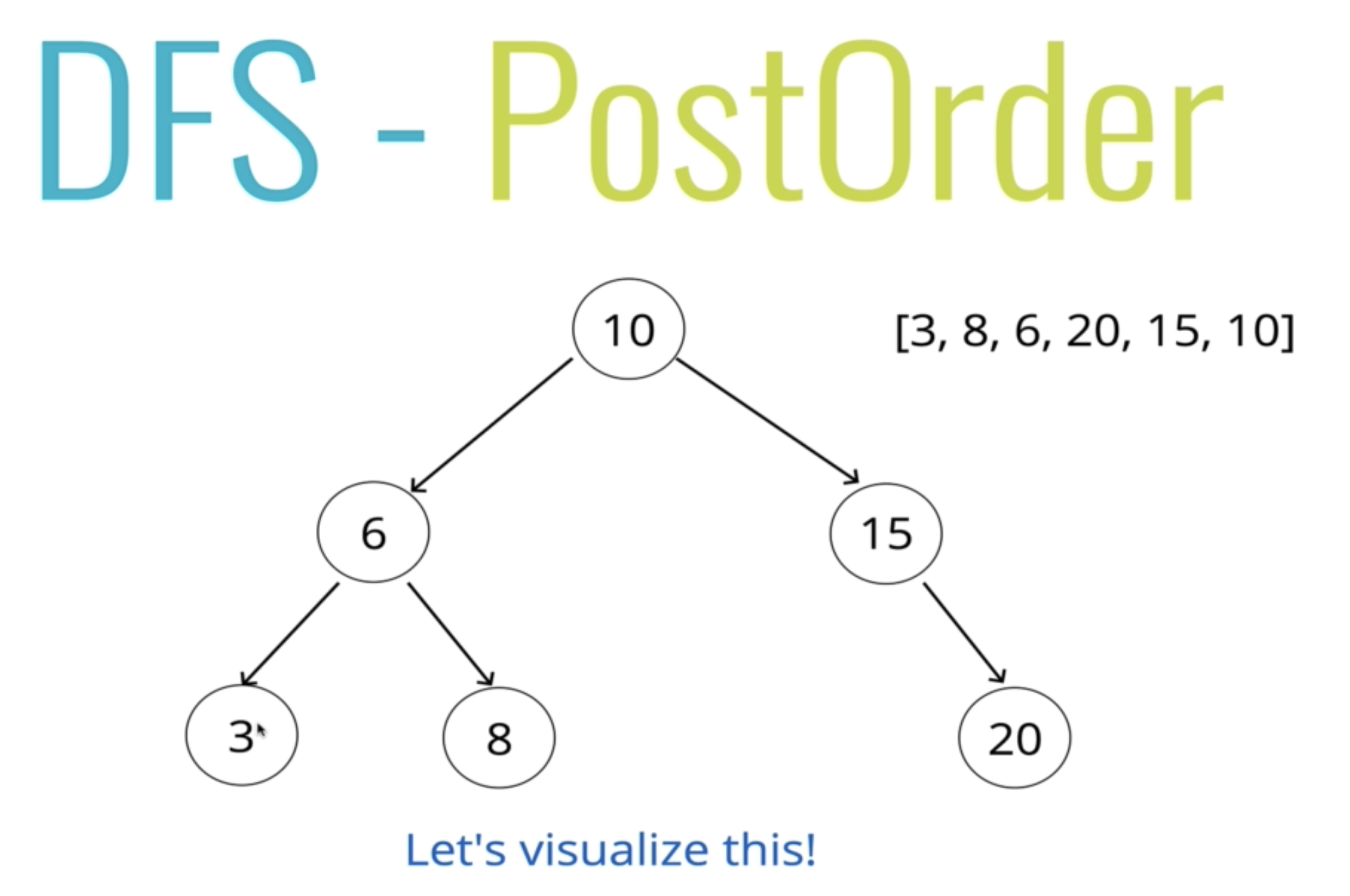
const BinarySearchTree = {
// 앞 생략
postOrderDFSByRecursive: function () {
const visited = [];
function traverse(node) {
if (node.left) {
traverse(node.left);
}
if (node.right) {
traverse(node.right);
}
visited.push(node.val);
}
traverse(this.root);
return visited;
},
};
const bst = Object.create(BinarySearchTree);
bst.init();
bst.insert(10);
bst.insert(6);
bst.insert(3);
bst.insert(8);
bst.insert(15);
bst.insert(20);중순위(in-order) DFS
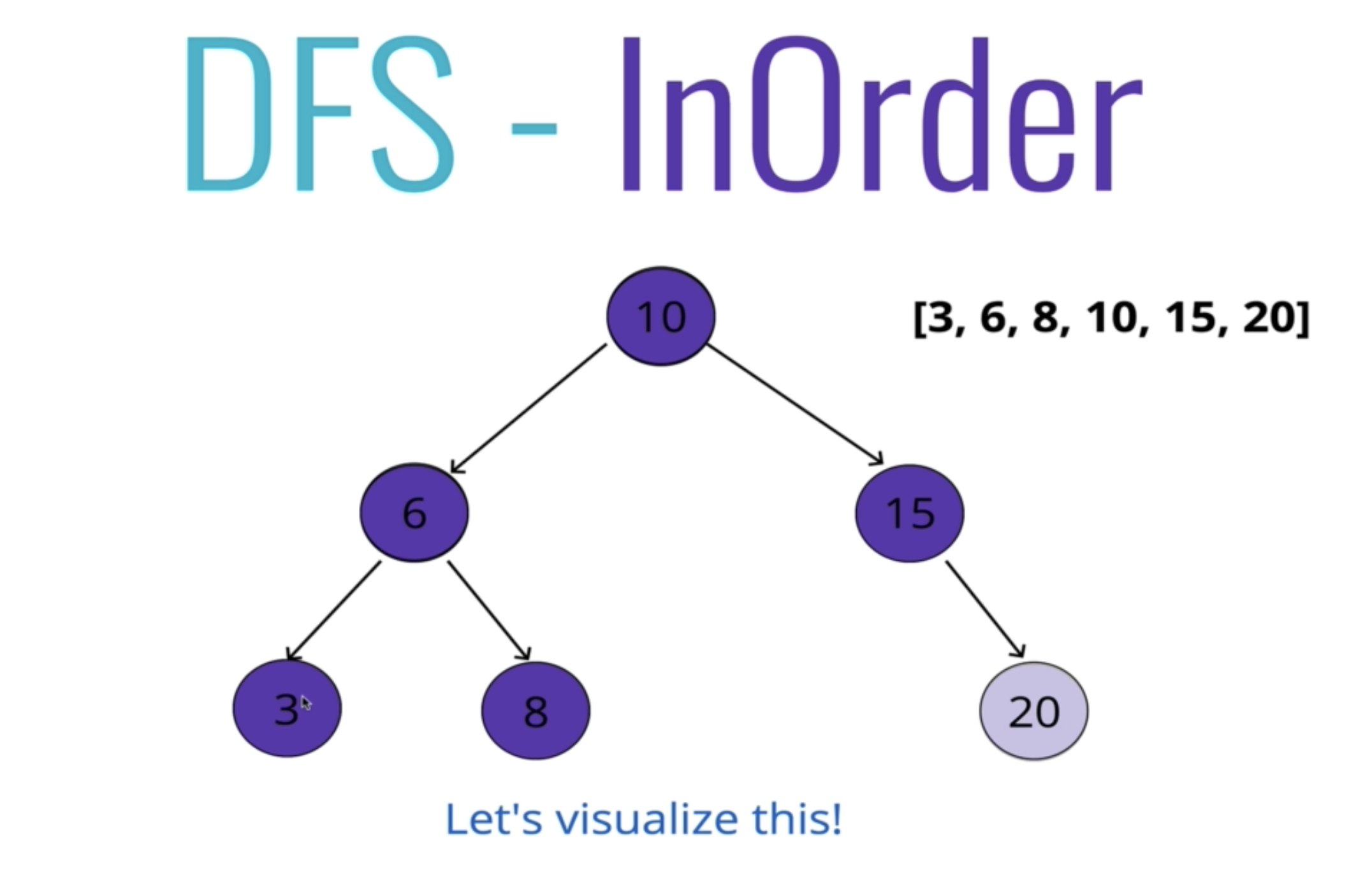
const BinarySearchTree = {
// 앞 생략
inOrderDFSByRecursive: function () {
const visited = [];
function traverse(node) {
if (node.left) {
traverse(node.left);
}
visited.push(node.val);
if (node.right) {
traverse(node.right);
}
}
traverse(this.root);
return visited;
},
};
const bst = Object.create(BinarySearchTree);
bst.init();
bst.insert(10);
bst.insert(6);
bst.insert(3);
bst.insert(8);
bst.insert(15);
bst.insert(20);전체 코드
const Node = {
init: function (val) {
this.val = val;
this.left = null;
this.right = null;
},
};
const BinarySearchTree = {
init: function () {
this.root = null;
},
insert: function (val) {
const newNode = Object.create(Node);
newNode.init(val);
if (!this.root) {
this.root = newNode;
return this;
}
let currentNode = this.root;
while (true) {
if (val == currentNode.val) {
return currentNode;
}
if (val < currentNode.val) {
if (currentNode.left == null) {
currentNode.left = newNode;
return this;
}
currentNode = currentNode.left;
continue;
}
if (val > currentNode.val) {
if (currentNode.right == null) {
currentNode.right = newNode;
return this;
}
currentNode = currentNode.right;
continue;
}
}
},
find: function (val) {
if (!this.root) {
return;
}
let currentNode = this.root;
while (true) {
if (val == currentNode.val) {
return currentNode;
}
if (val < currentNode.val) {
if (currentNode.left) {
currentNode = currentNode.left;
continue;
}
return;
}
if (val > currentNode.val) {
if (currentNode.right) {
currentNode = currentNode.right;
continue;
}
return;
}
}
},
bfsByLoop: function () {
const queue = [this.root];
const visited = [];
while (queue.length) {
const shifted = queue.shift();
if (shifted.left) {
queue.push(shifted.left);
}
if (shifted.right) {
queue.push(shifted.right);
}
visited.push(shifted.val);
debugger;
}
return visited;
},
bfsByRecursion: function (queue = [this.root], visited = []) {
if (queue.length == 0) {
return visited;
}
const shifted = queue.shift();
if (shifted.left) {
queue.push(shifted.left);
}
if (shifted.right) {
queue.push(shifted.right);
}
visited.push(shifted.val);
debugger;
return this.bfsByRecursion(queue, visited);
},
preOrderDFSByLoop: function () {
const stack = [this.root];
const visited = [];
while (stack.length) {
const popped = stack.pop();
if (popped.right) {
stack.push(popped.right);
}
if (popped.left) {
stack.push(popped.left);
}
visited.push(popped.val);
debugger;
}
return visited;
},
// preOrderDFSByRecursive: function (stack = [this.root], visited = []) {
// if (stack.length == 0) {
// return visited;
// }
// const popped = stack.pop();
// if (popped.right) {
// stack.push(popped.right);
// }
// if (popped.left) {
// stack.push(popped.left);
// }
// visited.push(popped.val);
// // debugger;
// return this.preOrderDFSByRecursive(stack, visited);
// },
preOrderDFSByRecursive: function () {
const visited = [];
function traverse(node) {
visited.push(node.val);
if (node.left) {
traverse(node.left);
}
if (node.right) {
traverse(node.right);
}
}
traverse(this.root);
return visited;
},
postOrderDFSByRecursive: function () {
const visited = [];
function traverse(node) {
if (node.left) {
traverse(node.left);
}
if (node.right) {
traverse(node.right);
}
visited.push(node.val);
}
traverse(this.root);
return visited;
},
inOrderDFSByRecursive: function () {
const visited = [];
function traverse(node) {
if (node.left) {
traverse(node.left);
}
visited.push(node.val);
if (node.right) {
traverse(node.right);
}
}
traverse(this.root);
return visited;
},
};
const bst = Object.create(BinarySearchTree);
bst.init();결론
-
BFS나 DFS나 시간복잡도는 동일하다.
(어차피 전체 노드를 순회하니까) -
결국 BFS와 DFS가 차이를 보이는 부분은 공간복잡도이다.
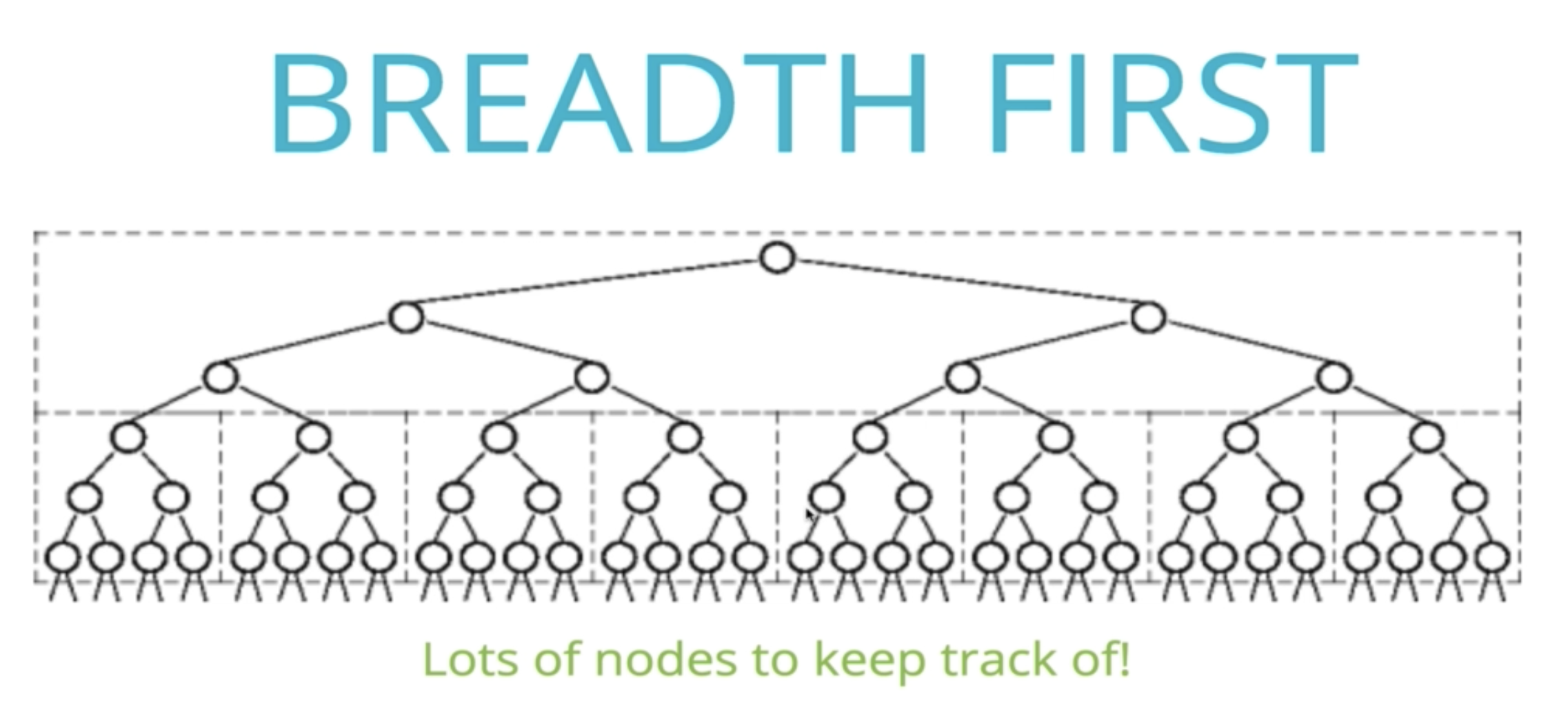
-
위 그림에서 깊이를 하나 내려올 때마다 큐의 길이는 2배가 된다.
-
따라서 깊이가 조금만 깊어져도 큐의 길이는 기하급수적으로 증가해 메모리를 많이 잡아먹는다.
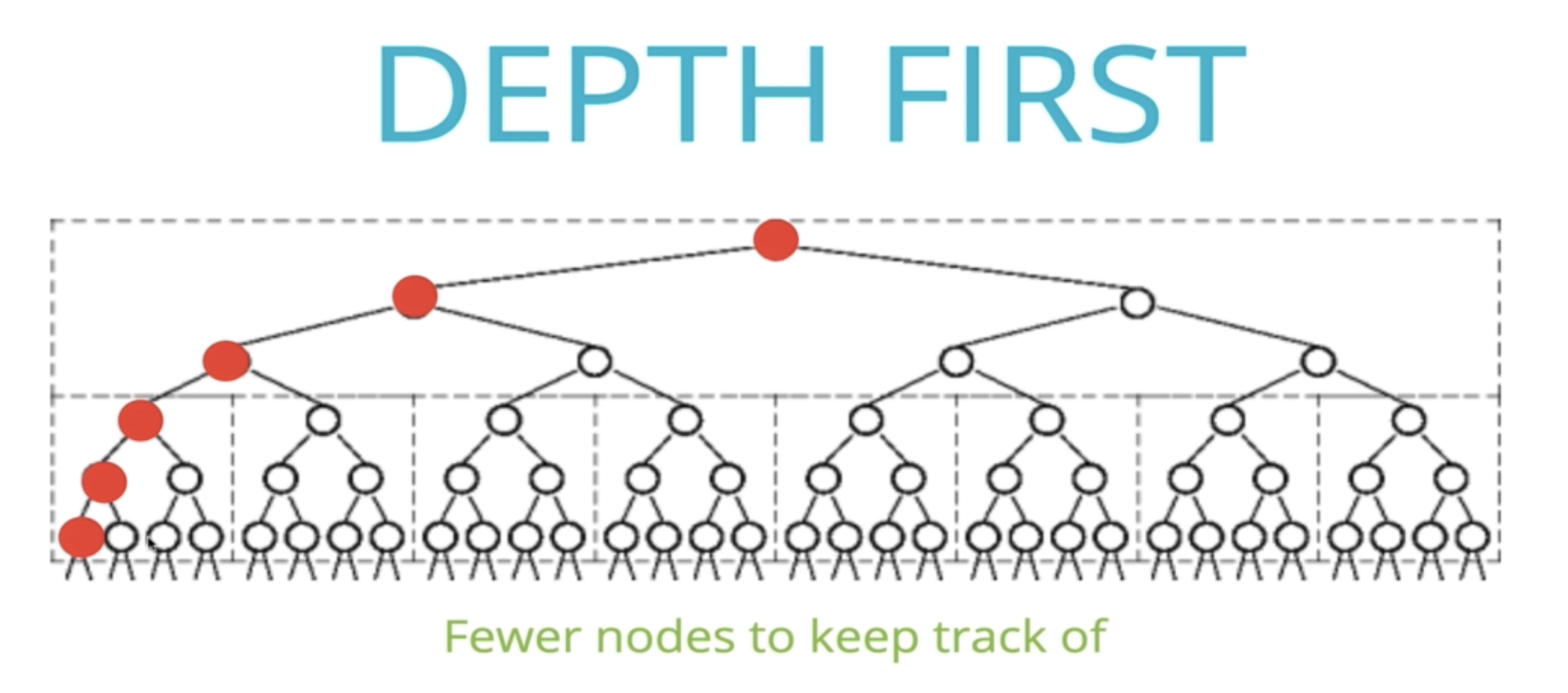
- 반면, DFS에서는 가지 치는 분기점마다 재귀 함수가 호출되어 콜스택이 하나씩 추가되기 때문에 BFS에 비해 상대적으로 메모리가 크게 절약된다.
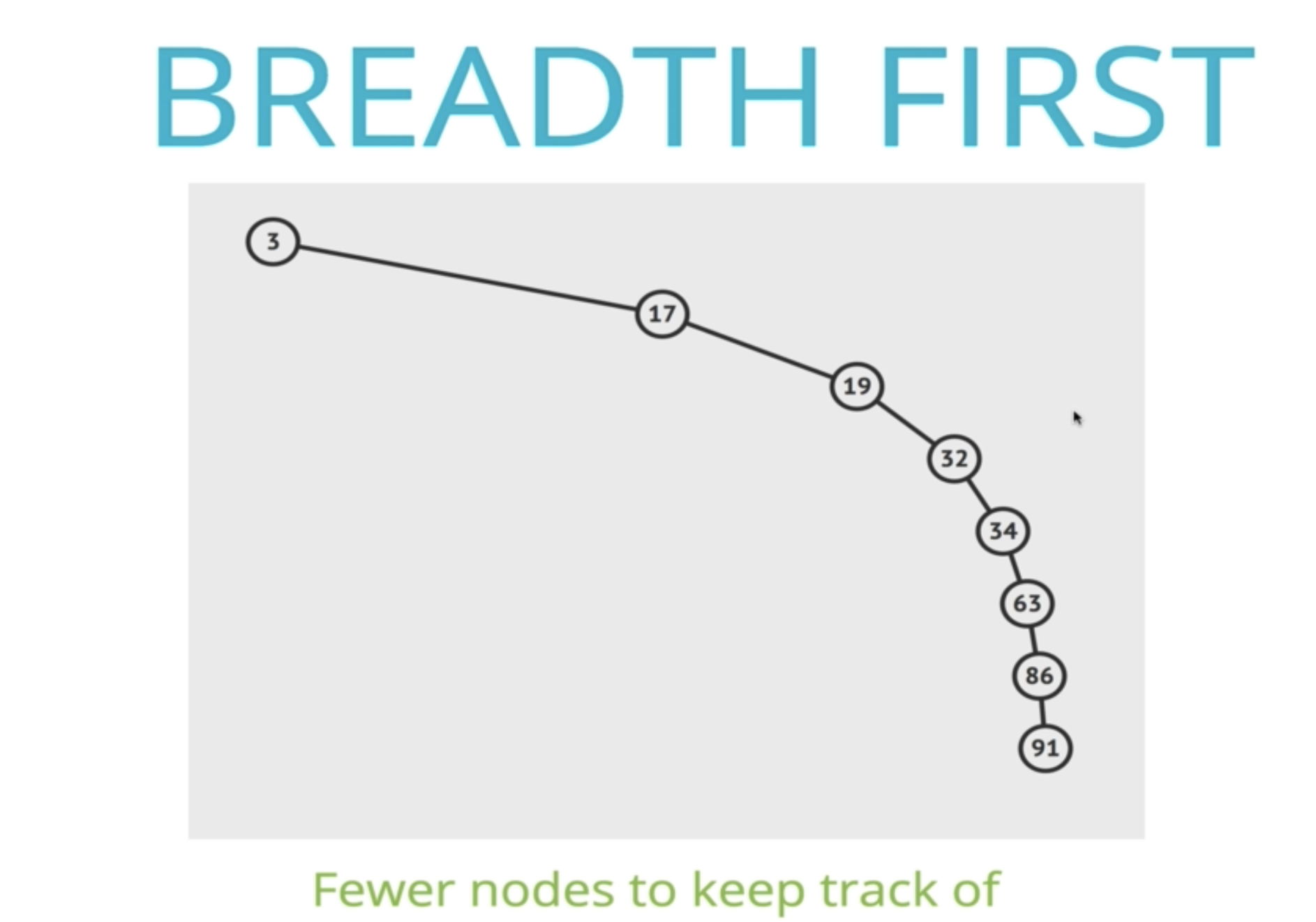
-
반대로 위와 같은 상황에서는 BFS가 압도적으로 메모리를 적게 사용한다.
-
큐에 언제나 1개의 원소만 존재할 것이기 때문이다.
-
반면, DFS의 경우 재귀 함수가 노드마다 호출되기 때문에 콜스택을 잡아먹고 있다.
-
AVL트리에 대해서는 이후에 기회가 된다면 이 포스팅에 내용을 추가할 예정이다.

